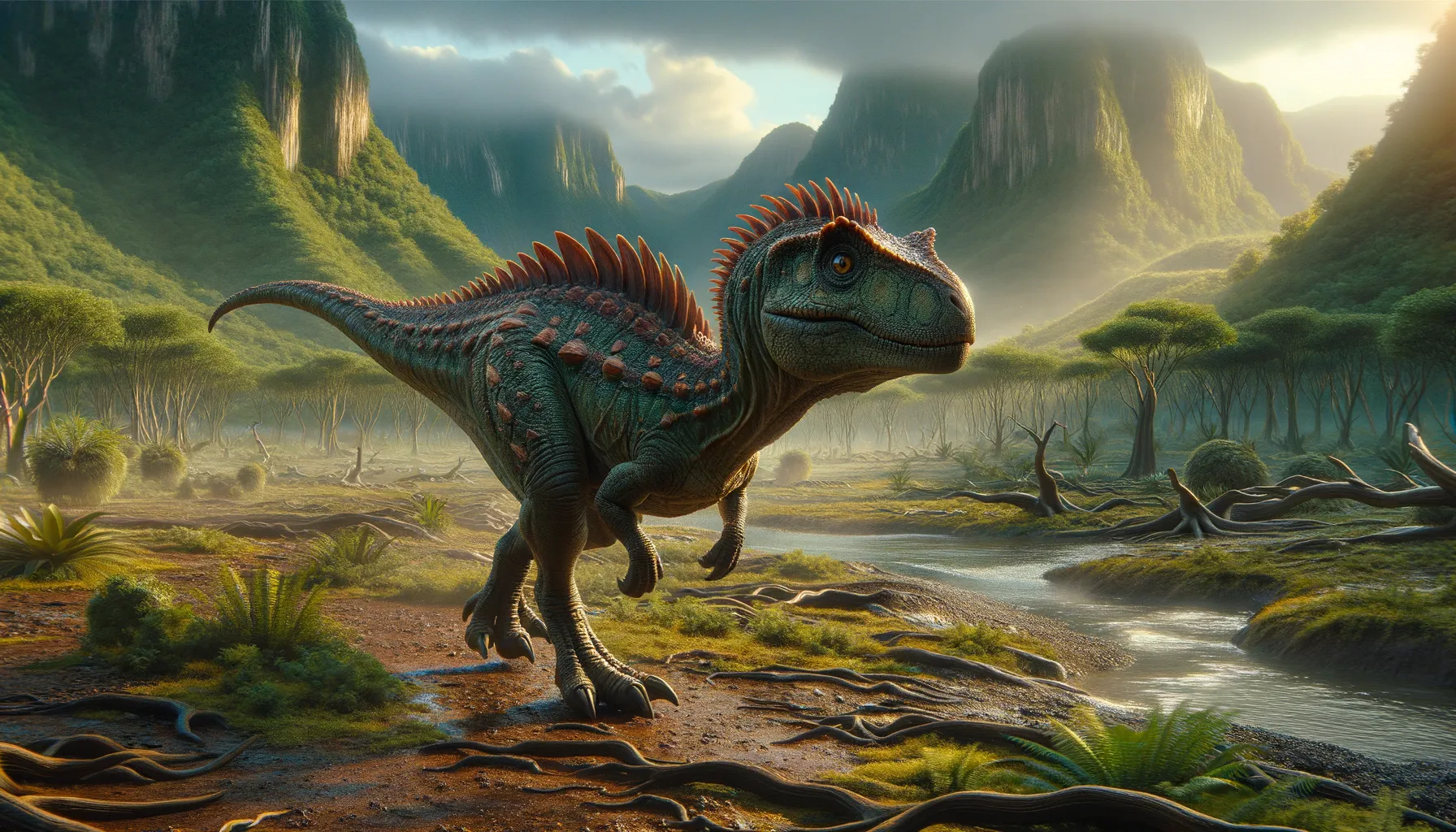
Scutellosaurus
Armor-clad sprinter of the Jurassic age.
Period
Jurassic
Length
About 1.2 meters long.
Height
Approximately 0.5 meters tall at the hip.
Weight
About 10 to 20 kilograms.
Scutellosaurus was a small, plant-eating dinosaur that roamed the Earth during the Early Jurassic period. Known for its bony plates running along its back, it was an early member of the thyreophorans, an armored group of dinosaurs. It had a long tail, which helped with balance, and a low-slung body that made it agile in escaping predators. Its small size and armor made it unique compared to its larger, more well-known relatives.
Diet
Scutellosaurus was a herbivore, primarily feeding on low-lying plants. Its small and leaf-shaped teeth were adapted for a plant-based diet, allowing it to chew leaves effectively. Its digestive system was likely specialized for breaking down tough plant fibers.
Hunting
Scutellosaurus did not hunt as it was not a carnivore. Instead, it spent much of its time foraging for plants and vegetation that suited its herbivorous diet. It might have used its keen sense of smell to locate food sources.
Environmental challenges
Living in the Early Jurassic period, Scutellosaurus faced the challenge of finding adequate food sources in a landscape dominated by gymnosperms. Predators were abundant, so it relied on its speed and agility for survival. Its bony armor provided protection against attacks from smaller carnivorous dinosaurs. Frequent environmental changes such as climate fluctuations would have influenced its habitat and food availability.
Speed
Moderate, able to move quickly due to long legs.
Lifespan
Lived likely up to 10-15 years.
First discovery
Discovered in Arizona, USA, in 1972.
Fun Facts
- Scutellosaurus was a small, early dinosaur that lived around 200 million years ago during the early Jurassic period.
- Despite being a dinosaur, Scutellosaurus was about the size of a dog, measuring around 4 feet long.
- This dinosaur's name means 'little shielded lizard' due to the small bony plates, or scutes, that covered its body.
- Scutellosaurus was a herbivore, munching on low-lying plants as it roamed ancient landscapes.
- Unlike many of its relatives, Scutellosaurus is believed to have been capable of both two-legged and four-legged movement.
- Fossils of Scutellosaurus have mostly been found in what is now Arizona, giving us a glimpse into the ancient ecosystems of North America.
- The bony plates on Scutellosaurus were likely used for protection against predators, making it one of the early armored dinosaurs.
Growth and Development
Scutellosaurus started life likely as a smaller, hatchling from an egg. As it grew, it developed its characteristic bony plates for defense. Growth rates were probably fast in youth to quickly reach a size less vulnerable to predators. Its skeletal structure suggests regular growth throughout its lifespan, with significant changes mostly occurring early in life.
Habitat
Scutellosaurus inhabited a variety of landscapes including open floodplains and forested areas. These environments provided ample plant life for its herbivorous diet. The semi-arid climate with seasonal rainfall played a role in its habitat preference and availability of shelter. Geological evidence suggests it lived in areas rich in water sources like rivers and streams.
Interaction with other species
As a smaller herbivore, Scutellosaurus likely had to coexist with both larger plant-eaters and predators. It may have traveled in small groups or flocks to increase its chances of spotting potential threats. Interactions with carnivores were likely marked by avoidance and quick escapes rather than direct confrontation. It contributed to the ecosystem by aiding in plant material breakdown through its digestion.
Natural lifespan
Given its size and environmental conditions, it likely lived around 10-15 years.
Reproduction
Scutellosaurus reproduced by laying eggs like most dinosaurs. Nests were likely built in secure, sheltered environments to protect against predators and environmental factors. Parental care once laid was possibly minimal, as the young were believed to be precocial, quickly adapting to mobile independence post-hatching. Breeding cycles likely aligned with favorable environmental conditions for offspring survival.
Social behaviour
Scutellosaurus might have exhibited flocking behavior, providing safety in numbers. Social interactions would have included communication through vocalizations or movements for group cohesion. Competition for resources within the group could have led to established hierarchies or territories. Their social structure was likely simple, favoring basic cooperation over complex social dynamics.
Fossil locations
Scutellosaurus fossils have predominantly been found in the Kayenta Formation of Arizona, USA. The area has provided a wealth of Early Jurassic fossil discoveries. These fossils have allowed paleontologists to piece together substantial information about this small, armored dinosaur. Ongoing excavations in the region continue to uncover more data about its existence.
